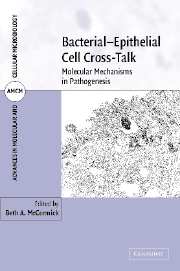Book contents
- Frontmatter
- Contents
- List of contributors
- Part I Introduction to the host and bacterial pathogens
- Part II Bacterial cell biology and pathogenesis
- Part III Host cell signaling by bacteria
- Part IV Exploitation of host niches by pathogenic bacteria: mechanisms and consequences
- 11 Lung infections
- 12 Interaction of Helicobacter pylori with the gastric mucosa
- 13 Interactions of enteric bacteria with the intestinal mucosa
- 14 Uropathogenic bacteria
- Index
- Plate section
- References
12 - Interaction of Helicobacter pylori with the gastric mucosa
from Part IV - Exploitation of host niches by pathogenic bacteria: mechanisms and consequences
Published online by Cambridge University Press: 12 August 2009
- Frontmatter
- Contents
- List of contributors
- Part I Introduction to the host and bacterial pathogens
- Part II Bacterial cell biology and pathogenesis
- Part III Host cell signaling by bacteria
- Part IV Exploitation of host niches by pathogenic bacteria: mechanisms and consequences
- 11 Lung infections
- 12 Interaction of Helicobacter pylori with the gastric mucosa
- 13 Interactions of enteric bacteria with the intestinal mucosa
- 14 Uropathogenic bacteria
- Index
- Plate section
- References
Summary
INTRODUCTION
Microbes populate virtually every square inch of the earth's surface. This success is due in large part to the numerous adaptation strategies they have developed to facilitate survival/persistence. The practical requirement for microbial resilience is particularly true of pathogenic microorganisms, as they must cope with host environments that are often actively adversarial. This is the case with Helicobacter pylori, which colonizes in the unlikely niche of the human stomach. Once in the stomach, H. pylori establishes a chronic infection in a manner that shows many similarities to what we typically think of as behavior of the host-adapted flora – “with an eye towards persistence rather than towards causing disease” (Merrell and Falkow, 2004). This is evidenced by the fact that severe disease typically takes decades to develop. This delayed development of overt pathology suggests that there is a balance shift that causes colonization to go awry and leads to disease. This shift is likely due to a combination of physiological and genetic factors for both participants of the host–pathogen interaction. On the bacterial front, H. pylori interacts with gastric mucosal cells and expresses a repertoire of factors that result in alterations in host cell signaling. These changes in host cell signaling are likely ultimately responsible for H. pylori-induced disease. Thus, H. pylori represents a model organism in terms of its ability to chronically exploit the gastric niche as well as to manipulate gastric epithelial cells (Figure 12.1).
- Type
- Chapter
- Information
- Bacterial-Epithelial Cell Cross-TalkMolecular Mechanisms in Pathogenesis, pp. 327 - 355Publisher: Cambridge University PressPrint publication year: 2006



